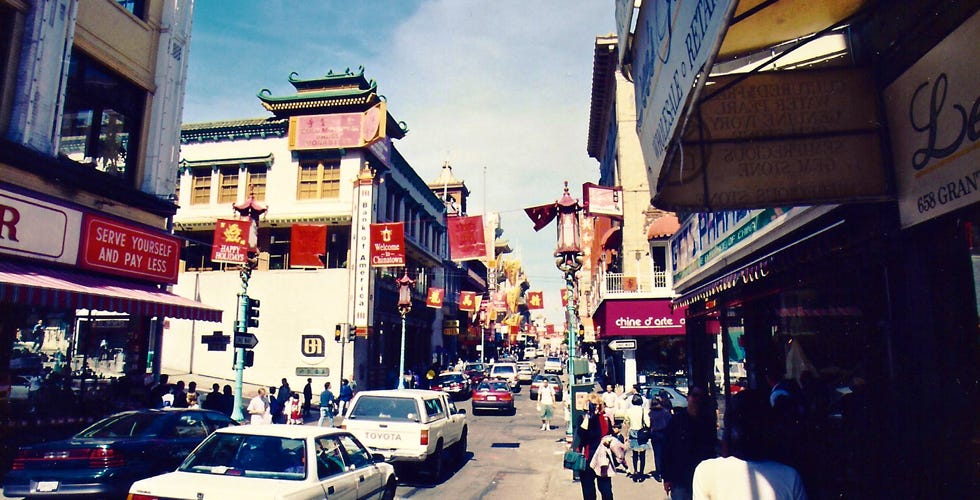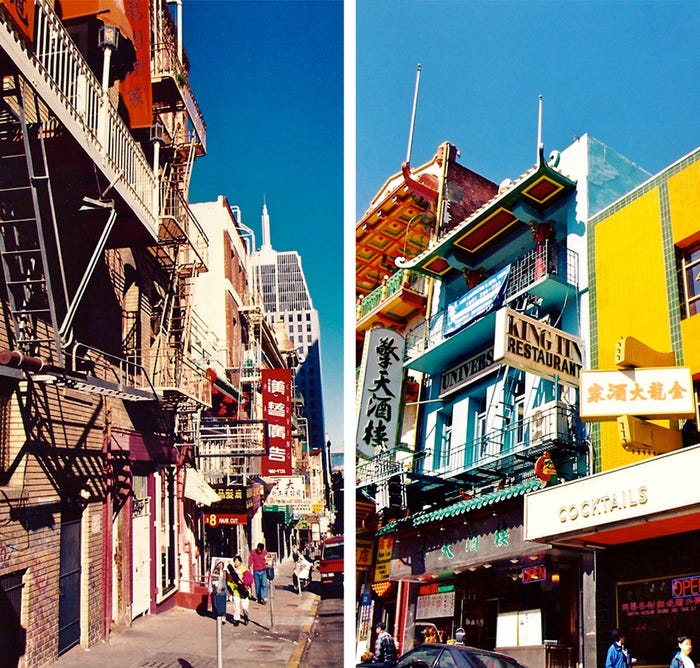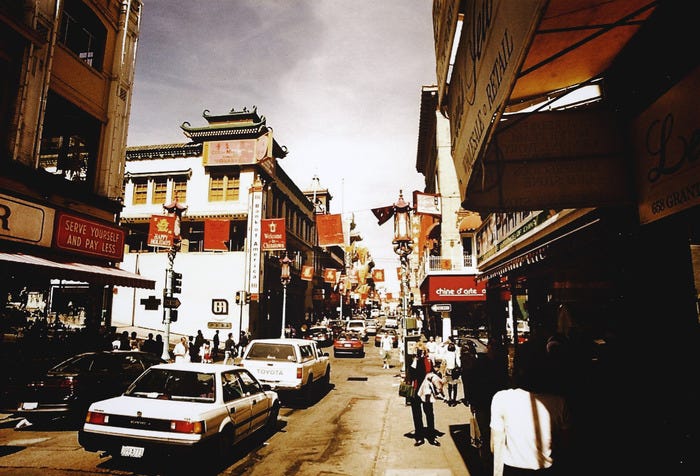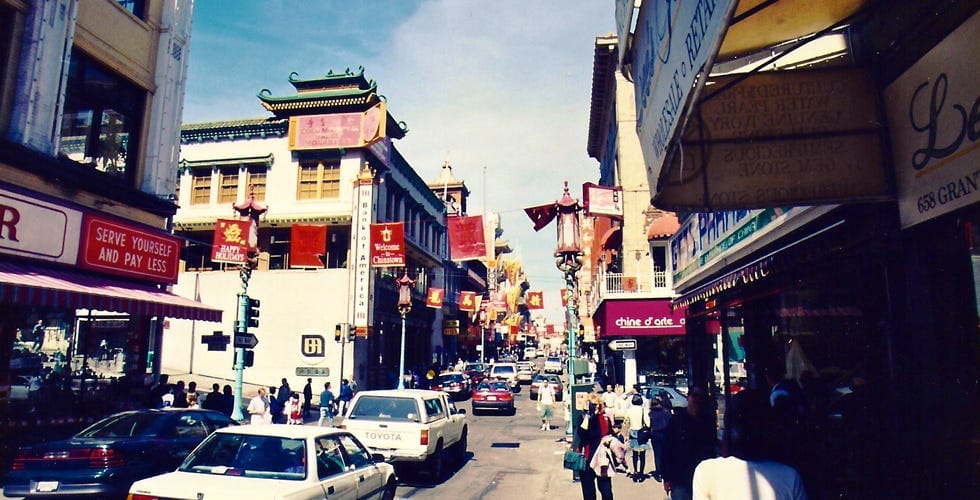


By Mike Walker
Chinatown has a reputation for being part of the tourist circuit, a place few people you know actually reside. It’s been my neighborhood for over a decade, and friends have actually asked me, “Do people live there? I mean, like, aside from a few old Chinese people?”
Yes, we do. Most residents are Chinese American, but there are other Asians, especially Vietnamese Americans, and a scattering of whites, Indians, and other ethnic groups. San Francisco’s Chinatown is the largest Chinatown in the United States, the largest cohesive community of Chinese Americans outside of China, and the largest population of Asian Americans in an expressly urban space (Orange County outnumbers us in sheer Asian American population, but is mainly suburban in composition).

Yes, over on Grant Avenue plenty of tourist-oriented places are selling cheap home furnishings, plastic “jade,” ninja swords, and other Asian-themed things to bedazzle, but Chinatown is a bona fide, thriving community unto itself.
In Chinatown you can get your printing done at Culture Lite or several other quality print shops, hit a laundromat on Waverly Place, and get all manner of foodstuffs from the green grocers, fishmongers, and other shops on Stockton Street, not to mention the scores of restaurants and Hong Kong–style bakeries.



History is everywhere you look — the type of history we have vague notions of in SF but rarely see manifest in physical form. History related to the gold rush. For example, consider the Chinese Benevolent Associations, which have been extant since the first wave of Chinese immigrants came to San Francisco and are crucial cultural institutions for Chinatown. The original and best known of these were called the “Chinese Six Companies” — associations organized to help Chinese immigrants gain greater social agency while steering them away from prostitution and other vices. If you look closely along Waverly Place, you’ll notice a number of doorways that have small signs in Chinese and English declaring that they are this or that Benevolent Association. You’ll also spot signs for immigration lawyers, and while Chinatown is no longer the epicenter for Chinese immigration it once was, it still plays a role. Beyond that, it is highly symbolic of the bridge between China and the U.S. for many Chinese Americans. And despite the vast, dense cities of China teeming with people, San Francisco is still known as dia foul (大埠) in China, or “the big city,” an indication — if there ever was one — of its cultural position.

Why, however, would someone like myself who is not Chinese wish to live here? For me, two leading reasons: One, I am very into the powerful, colorful, aesthetic of Chinese pop culture — everywhere you look in Chinatown there is something interesting to see, and little of it is generic or needlessly beautified. Second, the location: Chinatown puts me in the center of downtown, with the ability to access Union Square, Market Street, and North Beach, all with ease. People make assumptions that buildings in Chinatown are all older and smaller than the rest of this subcompact city. They wonder if the attraction is all about lower rents. Well, the rent is, in many cases, better than elsewhere in SF, and most apartments I’ve seen are of decent size.



And there are other advantages to my neighborhood. The food is also a huge deal. I have some of the best Chinese food in the West right outside my door, and much of it is inexpensive. The best bet for dining here, especially in the wee hours of the morning, is Yuet Lee Seafood on the north end of Stockton. The building is painted a bright poison-green inside and out, and the restaurant remains open late. After midnight, this den of aunties and uncles quickly becomes the domain of clubbers, drunks, and cops all looking for some yummy Cantonese seafood. On crowded nights you’ll often find a cop, an old Chinese man, and a couple kandi ravers sharing the last free table.

More than anything though, I love living in Chinatown because I feel like I’m part of a community — even though I’m not Chinese and I don’t speak Chinese (I’ve learned some Cantonese, but I’m nowhere near fluent), I feel like I’m in a small town. That’s rare in urban America nowadays and it still is a rare feeling here, despite SF’s neighborhood friendliness. People greet each other in Chinatown. If you’ve lived here longer than a few months, your neighbors realize you’re now a neighbor too and treat you accordingly. There is a spectrum of humanity here. The fabled aunties and uncles, but also teenagers, middle-aged folks, and students from the Academy of Art University living in the midst of their scattered campus.



Most of the population of Chinatown is of Cantonese origins and the spoken Chinese you’ll hear in the Stockton Street shops is more often than not the Cantonese dialect. Of course, there are Chinese who came from other regions. Of especial note are the Hakka –if you know something about spoken Chinese, you’ll occasionally pick up on the sound of their unique and sonorous language. Another sound you’ll hear is that of Canto-pop, or C-pop, the pop music of Hong Kong, floating out of various businesses. Before the music of these pop stars was available on iTunes, I used to buy their CDs in small record and gift shops here. C-pop hasn’t won over a large non-Asian fanbase the way J-pop has, but it’s enchanting music somewhere between contemporary mainstream pop and Gloria Estefan’s ornate, sappy love songs. Most people decide they either love it or hate it after hearing only a song or two.

I’ve had an obsession with C-pop, as well as anime and manga, long before they gained followings in the States, and living in Chinatown has allowed me an immersion into another country’s pop culture on a very nuanced level. No, this is not the same as living in China, but it does provide aspects of Chinese-American pop culture I would not likely find elsewhere. The Yes! Magazine (kinda like a Tiger Beat for Hong Kong but far cooler), the music, the guys in their late teens getting elaborate hairstyles in local beauty salons all open a window to a world I seldom encounter otherwise. It’s the world of Cantonese pop life, a multigenerational culture that requires a functioning urban sphere to flourish.



I love walking past a doorway and hearing Leon Lai (auntie music) to the left and Shinee (a Korean K-pop band that’s now huge in Hong Kong) to the right. And I also love all the conversations that happen with people on the street — the fate of the Chinese Hospital is a favorite topic these days, as the old but still very much in-use facility is undergoing a long renovation. The way people speak of the building, you’d be forgiven for thinking it’s the only hospital in town. Which, for Chinatown it is in a sense, because indeed this is a town, and one complete with nearly everything, even its own hospital.
Check out more neighborhoods that we covered in our “Why I Love …” series here.







